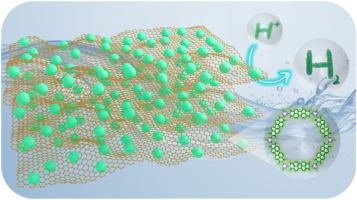Polyimide-based triazine-cored covalent organic frameworks supported metal (Fe, Ni, Ru and Rh) nanoparticles for high-efficiency electrocatalytic hydrogen evolution
IF 8.3
2区 工程技术
Q1 CHEMISTRY, PHYSICAL
引用次数: 0
Abstract
Covalent organic frameworks (COFs) have great potential in electrocatalytic hydrogen evolution reaction (HER). Nevertheless, it is a challenging task to fabricate COF-based electrocatalysts with low overpotential and high stability for HER in acidic media. Herein, a series of polyimide-based triazine-cored COFs (PIT-COFs) with different aromatic diimides are designed to support metal (Fe, Ni, Ru and Rh) nanoparticles for electrocatalytic HER. PIT-COFs are obtained by the reaction between melamine and aromatic (benzene, biphenyl, naphthalene and perylene) diimides. PIT-COFs based on perylenediimide show the optimal electrocatalytic HER activity in acidic media due to its large π-conjugated structure. Rh@COFMA-PT has a low overpotential value of 70 mV at 10 mA cm−2 and a small Tafel slope of 56.58 mV dec−1, which surpasses numerous previously published HER electrocatalysts. Furthermore, Rh@COFMA-PT exhibits good electrocatalytic stability and still keeps high activity after 3000 cycles. The conjugated nitrogen-rich structures of PIT-COFs and their ability to effectively anchor metal nanoparticles as active sites significantly promote the electron and proton transport during the electrocatalytic HER process. This work offers a guideline for developing effective and stable COF-based HER electrocatalysts with abundant active sites.

支持金属(Fe、Ni、Ru 和 Rh)纳米粒子的聚酰亚胺基三嗪共价有机框架,用于高效电催化氢气进化
共价有机框架(COFs)在电催化氢进化反应(HER)中具有巨大潜力。然而,在酸性介质中制备过电位低、稳定性高的 COF 型氢催化电催化剂是一项具有挑战性的任务。在此,我们设计了一系列具有不同芳香族二亚胺的聚酰亚胺基三嗪涂层 COF(PIT-COF),以支持用于电催化 HER 的金属(铁、镍、钌和铑)纳米粒子。PIT-COFs 由三聚氰胺和芳香族(苯、联苯、萘和过烯)二亚胺反应得到。基于过二亚胺的 PIT-COF 因其大 π 共轭结构而在酸性介质中显示出最佳的电催化 HER 活性。Rh@COFMA-PT 在 10 mA cm-2 条件下的过电位值低至 70 mV,塔菲尔斜率小至 56.58 mV dec-1,超过了之前发表的众多 HER 电催化剂。此外,Rh@COFMA-PT 还具有良好的电催化稳定性,在循环 3000 次后仍能保持较高的活性。PIT-COFs 的富氮共轭结构及其作为活性位点有效锚定金属纳米粒子的能力,极大地促进了电催化 HER 过程中的电子和质子传输。这项研究为开发有效、稳定、具有丰富活性位点的 COF 型 HER 电催化剂提供了指导。
本文章由计算机程序翻译,如有差异,请以英文原文为准。
求助全文
约1分钟内获得全文
求助全文
来源期刊

International Journal of Hydrogen Energy
工程技术-环境科学
CiteScore
13.50
自引率
25.00%
发文量
3502
审稿时长
60 days
期刊介绍:
The objective of the International Journal of Hydrogen Energy is to facilitate the exchange of new ideas, technological advancements, and research findings in the field of Hydrogen Energy among scientists and engineers worldwide. This journal showcases original research, both analytical and experimental, covering various aspects of Hydrogen Energy. These include production, storage, transmission, utilization, enabling technologies, environmental impact, economic considerations, and global perspectives on hydrogen and its carriers such as NH3, CH4, alcohols, etc.
The utilization aspect encompasses various methods such as thermochemical (combustion), photochemical, electrochemical (fuel cells), and nuclear conversion of hydrogen, hydrogen isotopes, and hydrogen carriers into thermal, mechanical, and electrical energies. The applications of these energies can be found in transportation (including aerospace), industrial, commercial, and residential sectors.
 求助内容:
求助内容: 应助结果提醒方式:
应助结果提醒方式:


